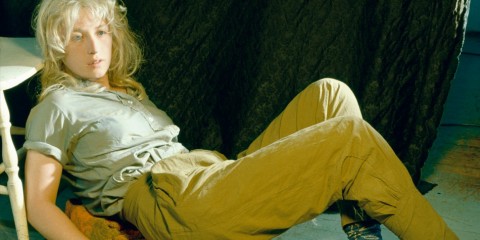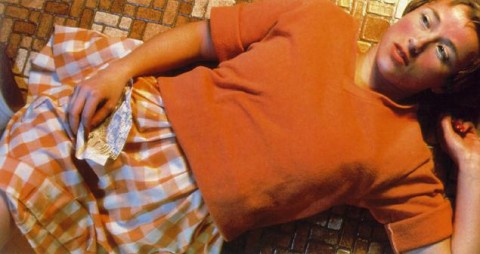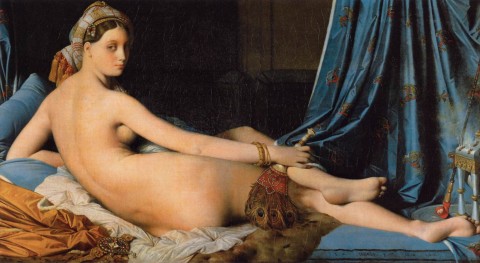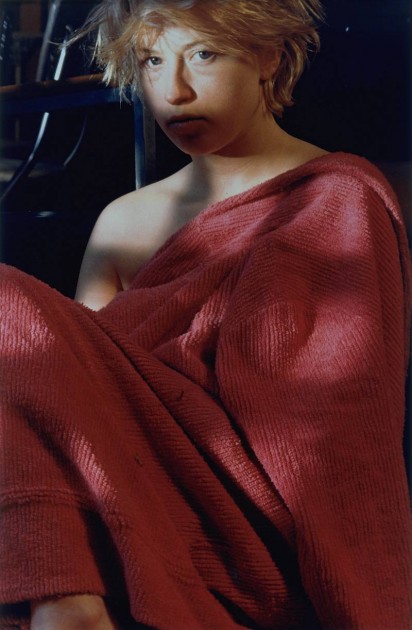Friday, April 11th, 2014
The Female Body and Horizontal Images
Over the past few weeks I’ve been reading Lives of the Artists by Calvin Tomkins. I’ve been thinking a lot about the chapter dedicated to Cindy Sherman, particularly when she discusses the controversy regarding her “Centerfolds” series from 1981. This series began as a commission from Artforum‘s editor Ingrid Sischy. The format of the commission would have involved two facing pages, which led Sherman to think about “centerfold” photographs from men’s magazines like Playboy. Sherman decided to highlight this reference by using a horizontal format for her photographs, although she added an element of irony by depicting clothed women in supine or semi-supine positions. However, the pictures were never included in the magazine; it was thought that the irony would be lost and “misunderstood” by militant feminists.1 Sherman continued to explore this horizontal format, however, and finished the “Centerfolds” series despite the rejection.
Reading about the “Centerfolds” series and its horizontal format has prompted me to think about about various ways in which the orientation of a work of art can convey meaning. I can understand why the horizontal orientation would be used for a centerfold in a magazine, if only for practical purposes. But I have realized that the horizontal format also is preferred for a lot of depictions of nude females over the centuries. The paintings that immediately come to mind for me are Titian’s Venus of Urbino (1538), Ingres’s The Grand Odalisque (shown below) and Gauguin’s Spirit of the Dead Watching (“Manao Tupapau”, 1892).
So, why would a horizontal format be preferred by some artists of the female form? I approached this topic through the lens of feminist analysis (in relation to female objectification and the “male gaze”), and here are some ideas which I came up with:
- The horizontal orientation the medium implies rest and repose. The image is “at rest” – as emphasized by the horizontal lines on the top and bottom of the canvas or medium itself. This suggestion of repose can perhaps suggest a contrast between the active viewer and the image itself.
- Repose and rest is emphasized in the horizontal orientation of the subject matter. In this way, the object can be interpreted as passive as well, which draws a contrast with the active viewer.
- It may be easier to objectify a body through a horizontal orientation, since the body might be more visually approachable to the viewer in a horizontal format. A horizontal body can fill the field of vision on part of the viewer, for example. Along these lines, viewers may find it more approachable to see a large-scale depiction of a body that is horizontally oriented: one may feel unable to objectify a vertically-oriented image in which the sitter towers over the viewer.
- A thought: Could it be that the female form is more predisposed to horizontal orientations because females are traditionally associated with the land and earth? I’m reminded of the horizon lines of landscapes and wonder if there might be some parallel. In contrast, I often think vertical lines often are associated more with masculinity (e.g. phallic imagery, skyscrapers, etc.).
Cindy Sherman noted herself that the horizontal format conveyed certain meanings to viewers of her “Centerfolds” series. She said, “…the horizontal format was a problem. Filling that space meant using some kind of prone figure, and that made it seem to some people that I was glorifying victims, or something.”2 As a change, Sherman decided to adopt a vertical format for her next series, called “Pink Robes.”
Although these vertically-oriented images do not automatically suggest a centerfold spread in a magazine, Sherman explained the following about the “Pink Robes” series: “I was thinking of the idea of the centerfold model. The pictures were meant to look like a model just after she’d been photographed for a centerfold. They aren’t cropped, and I thought that I wouldn’t bother with make-up and wigs and just change the lighting and experiment while using the same means in each.”3
In contrast to the objectification that seems to be implied through the horizontal orientation of the “Centerfolds” series, I think that “Pink Robes” puts more stress on the subjecthood and identity of the model, particularly due to the vertical format. The subjects imply activity and alertness because they are propped “upright” through the vertical position of the frame. Even though the subjects in these scenes imply some vulnerability through their loosely-draped pink chenille bathrobes, the vertical format still suggests strength and presence.
What types of meanings do you think can be conveyed through horizontally- or vertically-oriented images of the female form? Can you think of other examples of representations of the female form which seem to relate to the orientation of the composition and medium?
1 Calvin Tomkins, Lives of the Artists (New York: Henry Holt and Company, 2008), 33.
2 Ibid., 34.
3 Paul Taylor, ‘Cindy Sherman’, Flash Art, no.124 (Oct.-Nov. 1985): 78-9. Source quoted online here: https://www.tate.org.uk/art/artworks/sherman-untitled-98-p77729/text-summary




Great topic. My sense is that many early nudes (i.e. 15th Century) were made for bedrooms, and were often connected to weddings and bedroom furniture. They were made for cassoni (chests), beds, wainscoting, etc. These often had elongated horizontal formats which accommodated the reclining figure well. But the figures could be male as well as female. As an interesting case, see Botticelli’s Mars and Venus, where Mars shows off more flesh than Venus! (The taboos against depicting the female nude persisted….)
Although reclining female nudes exist from the 15th Century (cassone decorations generally), the norm of the reclining female nude–and the abiding connection between horizontality and femininity–comes a bit later, I think (early 16th Century and Giorgione?).
Narcissus might an interesting test case. He’s often depicted as a reclining nude (or semi-nude), but he’s also a pretty boy (i.e. effeminate). So perhaps ultimately confirms the horizontal-equals-feminine pattern. Manet’s Olympia also comes to mind: the “grand horizontal” who, with her propped up head and chest, refuses to be completely horizontal. And the slippers strongly imply she’s been walking around… Both components of her subversiveness?
Hi Ben! Thanks for your comment. I agree with what you are saying about cassoni and beds. That’s a good point. I also thought about how male figures have been depicted in a horizontal format, though I didn’t delve into that topic in my post. The painting that I had in mind was Drouain’s “The Dying Athlete” (1785).
You bring up an interesting test case with Narcissus. The first Narcissus painting which comes to mind for me is one by Caravaggio. Although that canvas is oriented vertically, the composition of Narcissus’s shoulder and arms is more horizontally oriented than vertical!
Hi, I enjoyed reading your post and do agree that a horizontal pose tends to show an extreme vulnerability in the person depicted. I thought about one or two older works which might reflect this.
Millais’ ‘Ophelia’
http://lizziesiddal.com/portal/ophelia/
This depiction of suicide albeit flowery gives us a sense of despair and hopelessness as she slowly begins to be dragged down beneath the water by the sheer weight of her clothes combined with her patience waiting for the inevitable.
There is also the total despair shown in A L Egg’s series of oil paintings ‘Past and Present’ (1858) in his depiction of the prostrate fallen woman, today’s viewer who almost appears to share their space can all but feel embarrassed to intrude upon such a powerful scene with its overwhelming silence possibly punctuated by sobs.
http://www.tate.org.uk/art/artworks/egg-past-and-present-no-1-n03278
Ben’s comments about the male horizontal figure made me consider Andrea Mantegna’s ‘Lamentation over the Dead Christ’ http://www.independent.co.uk/arts-entertainment/art/great-works/great-works-the-dead-christ-by-andrea-mantegna
which puts the viewer precisely where they don’t want to be at the foot of the tomb perhaps reflecting their own vulnerability in the face of seeming disaster. Interestingly Mantegna never sold this one in his lifetime perhaps the sheer starkness did not appeal to patrons the limited palette rendering it all too horrific. it was however sold after his death.
Hi, M! I haven’t visited in a long time, but I’m glad I saw this post. When talking about horizontal vs. vertical formats I immediately thought of formal portraits, circa 18th century. Even when a woman was depicted as a goddess, it would have been very improper to see her lying down. That would imply sexuality, illness, or inebriation (think The Drunken Satyr). I think you could take that beyond art and imagine how differently you would feel about the president or the pope if you saw them lying down! It would feel too intimate for such a personage.
The funny thing about this is that most centerfolds I recall seeing had women standing up.
Hi Patsy! Thank you for your comment. I think you have a great point about how the horizontal format can suggest vulnerability – which in many contexts (especially a magazine centerfold) can lead to objectification. I especially like the Millais and Mantegna examples that you highlighted. Millais’s “Ophelia” seems much more vulnerable than the painting of Ophelia by Waterhouse, which is horizontally oriented: http://upload.wikimedia.org/wikipedia/commons/4/4f/Ophelia_1894.jpg
Hi Val! Thanks for your comment! I agree with what you are saying about figures lying down as improper, and I think it ties into what Patsy said in her comment about vulnerability. In fact, your comment made me think about the contemporary artist Maurizio Cattelan’s sculpture of President John F. Kennedy (titled “Now” from 2004), which shows a wax figure of JFK in a coffin:
http://2.bp.blogspot.com/_94MHBXuNWGg/S_CSxKavWUI/AAAAAAAACuc/UGg-ADBDiW0/s1600/Maurizio+Cattelan+02+.arte_facto+hereges+pervers%C3%B5es+23.jpg
http://www.artnet.com/Magazine/reviews/walrobinson/Images/robinson10-11-1.jpg
I think one of the reasons that Cattelan wanted to impact his audience was by depicting Kennedy as lying down (while also barefoot and in a coffin no less!), because it would be unexpected in terms of portraiture.
Cecil Beaton did many photographs of woman lying down but viewed from above.Some his subjects asked to be photographed in this way.
Hi Bill! Thanks for your comment about Cecil Beaton. That is interesting that some of his subjects asked to be photographed lying down. A quick Google Search suggests that Beaton favored a vertical orientation for many of his film prints. I’ll keep my eye out for photographs that have women lying down (either with the print oriented vertically, horizontally, or square). Perhaps the request of the sitter influenced the way that Beaton decided to orient his camera for the shot?